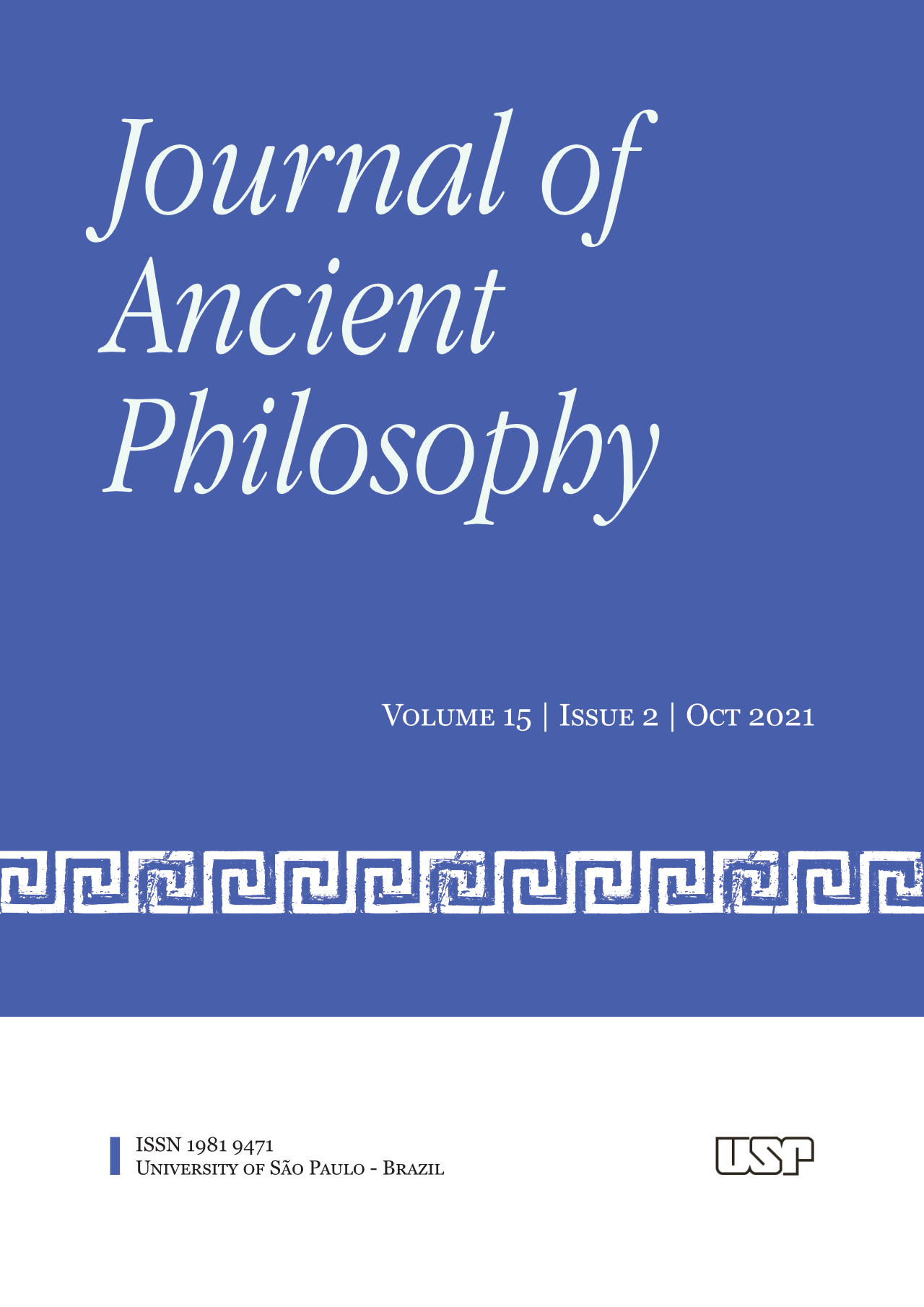Education, Conflict and Harmony in Book 1 of Plato’s Laws
DOI:
https://doi.org/10.11606/issn.1981-9471.v15i2p29-52Keywords:
Plato, Leges, education, conflictAbstract
Book 1 of Plato’s Laws, and particularly the image of the puppet introduced near its end, has been traditionally interpreted as presenting the moral psychology model that underlies the educational system delineated by the Athenian Stranger, which construes virtue as consonance between the non–rational and the rational elements of the soul. But a different and competing conception of virtue looms large in Laws 1, virtue as victory of the best part of the soul in psychic conflict. This paper argues that the Athenian’s conception of education as the correct conformation of originally conflicting psychic forces requires the simultaneous presence of the harmony and the conflict models of virtue in Laws 1. Education is in turn defined by calculation, the rational activity which persuasively leads the conflicting non–rational forces towards a consonant reciprocal rapport. By strategically developing his understanding of education and calculation in Laws 1, the Athenian shows how the harmony model of virtue overcomes the conflict model, while at the same time recognising that there is some truth to the conflict model after all and integrating it within the harmony model.
Downloads
References
Annas, J. Virtue and law in Plato and Beyond (Oxford: Oxford University Press, 2017).
Belfiore, E. ‘Wine and the Catharsis of Emotions in Plato’s Laws’, Classical Quarterly 36/2 (1986) 421–37.
Bobonich, C. Plato’s Utopia Recast: His Later Ethics and Politics (Oxford: Clarendon Press, 2002).
Folch, M. The City and the Stage: Performance, Genre, and Gender in Plato’s Laws (Oxford: Oxford University Press, 2015).
Fossheim, H. ‘The Prooimia, Types of Motivation, and Moral Psychology’, in C. Horn, comp., Platon: Gesetze – Nomoi (Sankt Agustin: Academia Verlag, 2013) 87–104.
Frede, D. ‘Puppets on strings: Moral Psychology in Laws Books 1 and 2’, in C. Bobonich, ed., Plato’s Laws: A Critical Guide (Cambridge: Cambridge University Press, 2010) 108–26.
Gaudin, C. ‘Humanisation de la Marionette. Plat. Leg. I 644c–645d; VII 803c–804c’, Elenchos 23 (2002) 271–95.
Gerson, L. Knowing Persons: A Study in Plato (Oxford: Oxford University Press, 2003) 265–70.
Giménez Salinas, J. A. ‘La psicología moral de la marioneta. Conflicto y acuerdo en las Leyes de Platón’, Ideas y Valores 68.171 (2019) 137–159.
Griffith, T. trans., and M. Schofield, ed., Plato: The Laws (Cambridge: Cambridge University Press, 2016).
Jorgenson, C. The Embodied Soul in Plato’s Later Thought (Cambridge: Cambridge University Press, 2018).
Jouët–Pastré, E. Le jeu et le sérieux dans les Lois de Platon (Sankt Augustin: Academia Verlag, 2006).
Kahn, C. ‘From Republic to Laws. A Discussion of Christopher Bobonich, Plato’s Utopia Recast’, Oxford Studies in Ancient Philosophy 26 (2004) 337–62.
Klosko, G. The Development of Plato’s Political Theory (Oxford: Oxford University Press, 2006).
Kurke, L. ‘Imagining chorality: wonder, Plato’s puppets, and moving statues’, in A. Peponi, ed., Performance and Culture in Plato’s Laws (New York: Cambridge University Press, 2013) 123–70.
Nightingale, A. ‘Plato’s lawcode in context: rule by written law in Athens and Magnesia’, Classical Quarterly 49 (1999) 100–22.
Pangle, T. The Laws of Plato (Chicago: University of Chicago Press, 1988).
Pfefferkorn, J. ‘Shame and Virtue in Plato’s Laws: Two Kinds of Fear and the Drunken Puppet’, in L. Candiotto and O. Renault, eds., Emotions in Plato (Leiden/Boston: Brill, 2020) 252–269.
Sassi, M. ‘The Self, the Soul and the Individual in the city of the Laws’, Oxford Studies in Ancient Philosophy 35 (2008) 125–48.
Sauvé–Meyer, S. ‘Review of Griffith and Schofield 2016’, Bryn Mawr Classical Review 2018.03.49.
Sauvé–Meyer, S. ‘Self–Mastery and Self–Rule in Plato’s Laws’, in D. Brink, S. Sauvé–Meyer, and C. Shields, eds., Virtue, Happiness, Knowledge: Themes from the Work of Gail Fine and Terence Irwin (Oxford: Oxford University Press, 2018) 97–109.
Sauvé–Meyer, S. trans. and comm., Plato’s Laws 1 and 2 (Oxford: Clarendon Plato Series, 2015).
Schofield, M. ‘Plato’s Marionette’, Rhizomata 4/2 (2016) 128–53.
Schofield, M. ‘The Laws’ Two Projects’, in C. Bobonich, ed., Plato’s Laws: A Critical Guide (Cambridge: Cambridge University Press, 2010) 12–28.
Wilburn, J. ‘Akrasia and Self–Rule in Plato’s Laws’, Oxford Studies in Ancient Philosophy 43 (2012) 25–53.
Zuckert, C. Plato’s Philosophers: The Coherence of the Dialogues (Chicago: University of Chicago Press, 2009).
Downloads
Published
Issue
Section
License

This work is licensed under a Creative Commons Attribution-NonCommercial 4.0 International License.
Copyright
Authors who publish with this journal agree to the following terms:
- Authors retain copyright and grant the journal right of first publication with the work simultaneously licensed under a Creative Commons Attribution License (CC By 4.0) that allows others to share the work with an acknowledgement of the work's authorship and initial publication in this journal.
- Authors are able to enter into separate, additional contractual arrangements for the non-exclusive distribution of the journal's published version of the work (e.g., post it to an institutional repository or publish it in a book), with an acknowledgement of its initial publication in this journal.
- Authors are permitted and encouraged to post their work online (e.g., in institutional repositories or on their website) prior to and during the submission process, as it can lead to productive exchanges, as well as earlier and greater citation of published work (See The Effect of Open Access).


